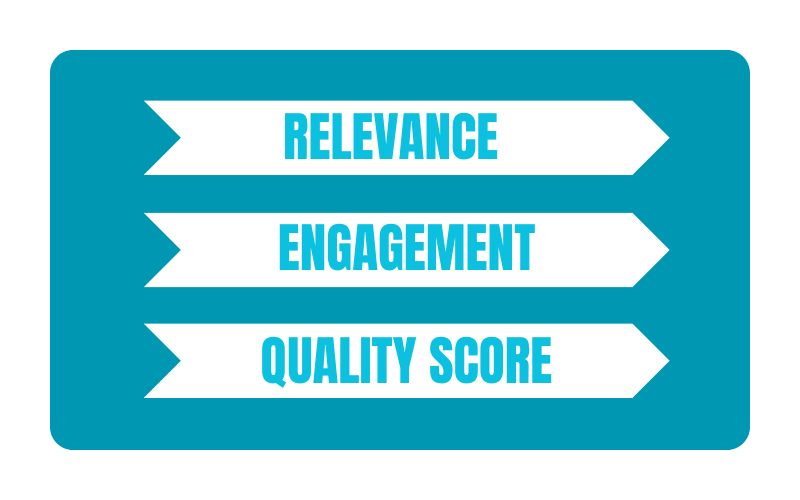Advertising is a vital strategy for businesses to utilize in order to introduce their goods and services to potential consumers. However, merely running an advertisement is inadequate to ensure success. To reach the demographic of interest and produce leads, advertisements have to be of outstanding craftsmanship and highly successful. It is always important to know what are the three main factors that determine ad quality?, to ensure the quality of your ads. This blog will go through the three major elements that influence ad quality: relevancy, engagement, and quality score.
The Importance Of Ad Quality:
- A high-quality advertising may capture the attention of your target audience, improve engagement, and push them to act.
- Relevancy, engagement, and quality score are all characteristics that determine ad quality.
- Ad quality can be improved through creating relevant and interesting advertising, enhancing the landing page experience, and raising quality ratings.
- To guarantee that their marketing strategies achieve the greatest results possible, advertisers must often evaluate and improve them.
- A greater click-through rate (CTR) might result in more conversions and revenues if the advertising is of excellent quality.
- Additionally, cheaper costs per click (CPC) and higher ad placement on search engines might result from ads that fulfill the standards for ad quality.
- On websites like Google Ads, advertisers may also benefit from improved ad positioning and cheaper expenses with a high ad quality score.
- Employing the three main factors that determine ad quality—relevancy, engagement, and quality score—can assist marketers in developing successful ad campaigns and achieving their corporate objectives.
- Employing the three key determinants of ad quality—relevancy, engagement, and quality score—can assist marketers in developing successful ad campaigns and achieving their corporate objectives.
- Ad quality may be the difference between a successful advertising campaign and wasted advertising budgets in today’s extremely competitive digital market.
The Ways To Improve Ad Quality:
Advertisers can utilize numerous strategies for improving ad quality. Your one of the approach is to undertake extensive studies on the target audience to understand their interests and habits, which is then utilized to choose relevant keywords and yield ad copy that connects with them. Another strategy is to continuously evaluate and enhance ad campaigns to discover areas for improvement, such as poor click-through rates or high cost-per-click, and then alter targeting and messaging appropriately. Split testing numerous ad versions may also aid in identifying the most effective ad design and messaging, which can then be included into future campaigns.

Incorporating calls-to-action (CTAs) into ad creative and landing sites can further improve ad quality by encouraging consumers to perform a specific action, such as purchasing or signing up for a subscription. For higher conversion rates, you need to create landing pages with brief content that complements ad copy. Make sure you create a user-friendly design to inspire action. Conversion-optimized landing pages can improve the efficiency of advertising campaigns.
The combined effort of ad creativity, keywords, and targeting defines ad quality in SMM and PPC advertising. The advertisements should be aesthetically appealing and relevant to the target audience, with a concise and easily understood message that promotes the offered product or service.Choose relevance and search volume when selecting keywords, keeping in mind the target audience’s interests and behavioral trends.. Targeting variables, including age, gender, geography, and interests, should be relied upon to guarantee that the ad will be displayed to the correct audience at the right time.
Advertisers can enhance ad quality and elevate the efficiency of their SMM and PPC advertising efforts by using these tactics. The impact of digital marketing on customer behavior is essential, since it could influence purchasing decisions, brand loyalty, and overall perception of a firm.”
What are the three main factors that determine ad quality?

These are the three main factors that determine ad quality, using these three main factors you can bring your ads to such a level that brings more attention and engagement for your brand.
1. Relevance
Relevance is an essential part that determines the efficiency of an advertisement. The significance of an advertisement correlates with how well it corresponds with the target audience’s interests, requirements, and desires. A relevant ad is more likely to attract the target audience’s attention and inspire interaction, resulting in increased click-through rates and conversions.
Advertisers ought to initially identify their target market and evaluate their interests, habits, and preferences in order to ensure that their ad is relevant to them wherever they go. Based on this data, businesses might adapt their message and creative aspects to appeal to their target demographic.
If an advertiser intends to promote a new line of athletic shoes, they should target individuals who have expressed an interest in sports and fitness. They can develop an advertisement with an athletic theme, emphasizing the characteristics and benefits of the shoes that are most relevant to their target demographic.
Advertisers should focus on the ad’s substance and messaging in addition to targeting the correct audience. The title, language, and images of the ad should all present a clear and engaging message to the target demographic.
2. Engagement:
Engagement is another crucial factor that determines ad quality. The extent of engagement refers to how efficiently an advertisement grabs the attention of the target audience and inspires them to act. A connecting advertisement is more likely to elicit clicks, shares, and conversions.
Advertisers should focus on the creative parts of the ad, such as the title, language, and images, to generate compelling advertising. The headline of the ad should be eye-catching and properly express the ad’s content. The language should be engaging and appealing, emphasizing the product’s distinct characteristics and benefits.
Visuals are equally crucial and should be engaging as well as important to the ad’s message. People are prone to interact with evidence that is visually pleasing and relevant to their interests, thus using high-quality photographs or videos may greatly enhance engagement rates.
Using humor or narrative to produce engaging commercials is another great strategy. Humor may make an advertisement more memorable and shareable, whereas narrative can develop an emotional connection with the target audience, increasing their likelihood of taking action.
3. Quality Score:
Quality score is a measure used by advertising companies like Google Ads in evaluating the efficiency of an ad. A quality score examines numerous criteria, including ad accuracy as landing page experience, and click-through rate.
A higher quality score indicates that an ad is more relevant to its target demographic and provides a better landing page experience, which results in greater click-through rates. A lower quality score represents that the ad is less relevant, the landing page experience is inadequate, and the click-through rate is low.
The quality score is important since it improves an ad’s visibility and cost per click. (CPC). Higher quality campaigns are more likely to be observed by the target demographic and cost less per click than lower quality ads.
Advertisers should work on enhancing ad relevance, optimizing the landing page experience, and raising click-through rate to increase an ad’s quality score. Advertisers may do this by analyzing and improving their ad campaigns on a regular basis, ensuring they are targeting the proper audience, and optimizing their ad creatives.
Finding the Right Balance: How Many Ads should be Implement per Ad Group?
Advertisers make use of ad groups to structure their adverts based on a similar subject or target audience. When creating ad groups, it is critical to evaluate the amount of advertising to be conducted to each group. Too few advertising will limit the campaign’s reach and performance, while too many commercials might make determining the performance of each ad difficult. We should take into account that the campaign’s objectives, target demographic, and available resources to calculate the appropriate number of advertisements to air for each ad group. To discover the best balance, advertisers should try different amounts of advertising and analyze their performance. Advertisers may increase the performance of their ad campaigns and increase their return on investment by achieving the correct balance. To achieve better results through split testing and optimization, it’s advisable to include at least 3-5 ads per ad group.
How many optimal Number of Keywords per Ad Group
Keywords are critical for ensuring that advertising is relevant to the suitable audience and that ads are displayed to them. Advertisers have to decide the appropriate quantity of keywords to use per ad group in order maximize the efficacy of their ad campaigns. Too few keywords might limit the campaign’s reach, while too many can make determining the performance of each keyword difficult. The ideal quantity of keywords per ad group is determined by the campaign’s goals, target audience, and available resources. To gain the greatest results, advertisers should review and improve their keyword approach on a regular basis. Advertisers may increase ad relevance and maximize their return on investment by determining the ideal amount of keywords. In order to Research keywords there are many tools such as SEMRUSH, Ahrefs etc.
Which Attributes Describe a Good Landing Page Experience?
A landing page is a vital element of every advertising campaign since it is where visitors arrive after clicking on an ad. A good landing page experience is critical for retaining users and motivating them to take action. A robust landing page experience includes elements such as page load speed, mobile responsiveness, relevant and meaningful information, clear call-to-actions, and simple navigation. To prevent viewers from abandoning the website before it loads, a landing page should load rapidly. The page’s content should be relevant to the ad and useful to the user. A clear call-to-action directs the user to the intended activity, while simple navigation ensures that users can easily locate what they need.
Conclusion:
In short, ad quality is a vital component of every successful advertising campaign. In order to improve one’s ad quality, one should always research what are the three main factors that determine ad quality? Advertisers have to consider relevancy, engagement, and quality score to produce high-quality advertisements. Advertisers can enhance ad quality and campaign performance by creating relevant and engaging advertising, enhancing the landing page experience, and raising quality reviews. Regular assessment and enhancement of ad campaigns is additionally crucial to offer the greatest possible outcomes. Finally, concentrating on ad quality is a sensible investment for all advertising executives since it may seize the attention of the target audience, increase engagement, and guide them to act.

